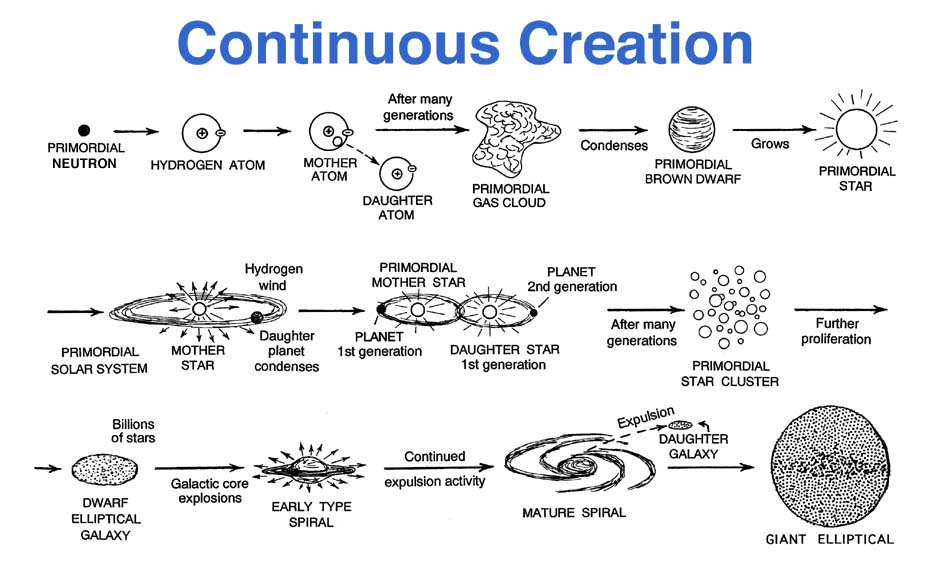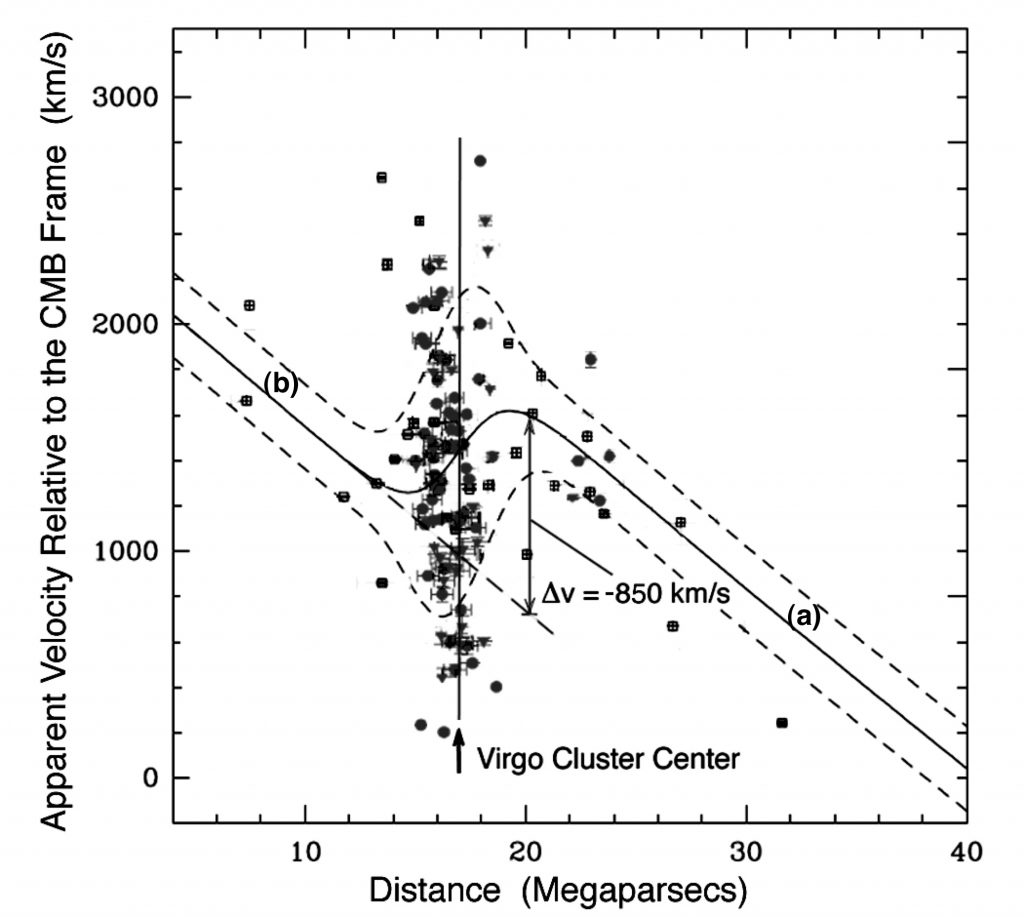Posted by: P. LaViolette
June 2, 2021, updated June 5, 2021
This week, two cosmology papers authored by Paul LaViolette were published in the June issue of the International Journal of Astronomy and Astrophysics. They may be downloaded here:
Expanding or Static Universe: Emergence of a New Paradigm
and
The Nonvelocity Cosmological Spectral Shift
Covered in the September 26, 2021 Sunday Daily Gazette: https://dailygazette.com/2021/09/25/did-niskayuna-man-solve-mystery-of-the-universe-he-thinks-so/
The two papers complement one another. Below is a summary of their achievements:
Expanding or Static Universe: Emergence of a New Paradigm.
A paper by Dr. Paul LaViolette of the Starburst Foundation, published this week in the International Journal of Astronomy and Astrophysics, (2021) vol. 11, tests the expanding universe hypothesis against the static universe, tired-light hypothesis to see which makes a better fit to data on 8 different cosmology tests. LaViolette finds that on all eight tests the tired-light alternative makes a far better fit. The introduction of ad hoc evolution assumptions was avoided in order to keep the comparison fair. He concludes that this multi-test comparison leads inevitably to the conclusion that the universe is not expanding and that the cosmological redshift is best explained if photons lose energy as they travel through intergalactic space.
The paper also examines the supernova study published in 2001 by the Supernova Cosmology Project team which claimed to have discovered time dilation in high redshift supernova and concludes that that study is flawed by selection effect biases, further undermining support for an expanding universe. In his paper, LaViolette also demonstrates how the static universe, tired-light model is able to better account for the redshift quantization effect, the existence of a multi-megaparsec periodicity in the cosmic distribution of galaxy superclusters, and for the existence of galaxies at high redshifts.
The present paper is an update of LaViolette’s landmark 1986 Astrophysical Journal paper which showed that the tired-light model made a better fit on 4 different cosmology tests. The new study reaches the same conclusion using more tests and including data at higher redshifts.
With the big bang cosmology defeated, LaViolette then explores what cosmology might reasonably take its place, one that does not require that Creation occurs all at once in a single explosive event. He offers the alternative notion of continuous matter creation, an idea toyed with by astronomers William McCrea and Sir James Jeans. LaViolette’s more fully developed continuous creation theory emerges as a corollary of a new approach to microphysics called subquantum kinetics (SQK), a theory that he developed by melding physics with the theory of open systems. SQK predicts that space at the subquantum level should be filled with subquantum medium that spontaneously produces zero-point energy fluctuations and that if one such fluctuation of sufficiently large size were to emerge in a region of negative gravity field potential, it would be capable of nucleating a subatomic particle, i.e., a neutron. It not only explains how this process happens, but has shown these particles graphically emerging using computer simulations of “Model G”, the set of partial differential equations that forms the basis of the theory. The field distribution in the centers of these simulated neutrons has been shown to fit observational data better than any other theory so far proposed.
Contrary to standard physics, zero-point fluctuations in SQK only lead to the spontaneous emergence of matter, as opposed to equal amounts of matter and antimatter. This matter bias is consistent with the observation that our universe is composed primarily of matter, something that had been problematic for the big bang theory which predicted the existence of antimatter galaxies.
SQK also predicts that its matter creation process proceeds most rapidly in the immediate vicinity of existing neutrons or protons, implying that matter should breed more matter at an exponentially increasing rate. This idea, which also was proposed on observational grounds by McCrea, in some ways resembles the process of cell division in biology. In his self published book Subquantum Kinetics LaViolette presents this matter creation cosmology in its most fully developed form, even going into the subject of the formation and growth of supermassive cores. The ebook is available from his website at: etheric.com/product/subquantum-kinetics-4th-edition-ebook.
The dissolution of the big bang theory presents a crisis in cosmology since most continuous creation theory replacements require very small violations of energy conservation with every particle materialization event. This is not a serious problem in SQK since the predicted energy creation is 10 orders of magnitude below the laboratory threshold of detection. SQK predicts not only that matter and energy should emerge spontaneously in regions of negative gravity potential, but also that photons traveling through intergalactic space (regions of positive gravity potential) should nonconservatively lose energy, the prediction that LaViolette tested and successfully verified in the first part of his paper.
The First Law of Thermodynamics maintains that energy may be neither created or destroyed within a closed system. Physicists have been indiscriminately applying this law throughout physics assuming that the observable universe operates as a closed system. However, such infractions of the energy conservation law are permissible in SQK which instead conceives that the universe functions as an open system, and as is well known, the First Law does not apply to open systems.
So, with the big bang theory now definitively disproven, physicists may now need to rethink their conception of the universe and realize that in fact it may operate as an open system, in some ways resembling life itself. Thus physics may be headed in a direction that in the future may bring it more under the umbrella of the life sciences. This paradigm shift also has substantial implications for green technologies such as the development of over-unity energy generators which conservative physicists in the past have been unwilling to accept as real due to their violation of the law of energy conservation. With the First Law called into question, “free energy” devices emerge as a reasonable reality that could save our world’s future.
The Nonvelocity Cosmological Spectral Shift.
This week Dr. LaViolette also published a second paper in the same issue of the International Journal of Astronomy and Astrophysics, one related to the paper discussed above. This second paper demonstrates observational validation for the subquantum kinetics (SQK) prediction of energy creation in regions of negative gravity field potential. Thus, rather than photons progressively losing energy and redshifting as they would when traversing intergalactic space, when passing through gravity wells that surround galaxy clusters and superclusters, SQK instead predicts that photons should progressively gain energy and blueshift. This “cosmological blueshift” effect may be envisioned as a kind of reverse tired-light effect.
His paper shows that this simple nonvelocity blueshift prediction is able to explain the observation that photons blueshift when passing through the Virgo cluster. The realization that this blueshift is not due to the motion of galaxies substantially reduces the mass that needs to be assumed to hold the Virgo cluster together, thereby reducing the need to assume the presence of large amounts of dark matter. LaViolette shows that the same blueshifting phenomenon also explains the mysterious Fingers-of-God effect and Kaiser effect observed when cluster spectra are plotted in redshift space. Neither of these effects have a good explanation in standard physics. In addition, he shows that this nonvelocity blueshifting effect is able to explain why the Hubble redshift-distance relation dips to negative values in the vicinity of the Local Group, the galaxy cluster that our Milky Way is a member of. This indicates that the Milky Way and our neighboring galaxies reside in a region where photon energy progressively but slowly increases over time. It also is shown to explain why Andromeda’s spectrum is seen to be blueshifted relative to us and why the primary galaxies in a galaxy cluster tend to be blueshifted relative to their companion galaxies, a finding first announced by Halton Arp but having no reasonable explanation forthcoming from standard astrophysics.
LaViolette’s second paper also examines the prediction that photons passing through cosmic voids, regions containing few galaxies, should redshift at a higher rate than the average intergalactic redshift rate due to the fact that such regions have a gravity potential higher than average. He shows that such excess tired-light redshifting is able to explain the Fingers-of-God effect seen when voids are plotted in redshift space and that it also explains why void galaxies tend to be subluminous compared to cluster galaxies.
SQK postulates a nonlinear reaction-diffusion medium as the substrate for all physical phenomena. This subquantum medium is predicted to function in a “subcritical” energy damping state in intergalactic regions where the gravitational potential is particularly high, a prediction validated in the first paper described above when tested against cosmological data. In addition, this same subquantum medium is predicted to function in a “supercritical” energy amplifying state in regions of low gravitational potential, as might exist in the vicinity of galaxy clusters and superclusters. So, we see that LaViolette’s theory follows the spirit of Occam’s razor, its gravity-potential-dependent photon energy prediction being able to explain in a simple fashion a large variety of seemingly unrelated phenomena that are separately not easily explained by standard theory. While the SQK methodology has been shown to be able to account for all accepted general relativistic effects such as gravitational lensing and the gravitational redshift, this particular gravity-dependent redshift vs. blueshift effect is unknown to relativity and is a feature forthcoming only from SQK.



Congratulations on your new published works.
Thank you
good job, matey!!